2015 financial services trends spanned a range of topics, from FinTech startups to a continued focus on mobile banking. FinTech startups were in the news with surprising regularity, though the amount of venture funding flowing into startups wasn’t surprising given the big IPOs of companies like Square and PayPal.
Amid the excitement over the private valuations of companies such as SoFi, Square and Betterment, one theme that stood out in 2015 was the reemergence of the concept of multichannel (or omnichannel) solutions. While often associated with just the use of multichannel marketing or customer service, omnichannel propositions such as Schwab Intelligent Portfolios seemed to gain traction over purely digital solutions.
To frequent conference attendees, “omnichannel” sounds like yesterday’s buzzword, but business models from firms as wide-ranging as Charles Schwab to Wells Fargo appeared to benefit from the ability to work with clients across multiple channels.
Through the evolution of omnichannel marketing, small but significant changes have made a big impact on the customer experience. For example, it was well-received when Bank of America added a button to its mobile app that enables clients to speak directly with agents. This tactic promoted a better customer experience across channels, as opposed to the email-centric practices employed by other firms.
New Consumer Options Emerge
Mobile was and continues to be a big theme in financial services. Innovators such as LOYAL3, the service that lets you “own what you love” with direct stock purchases, just unveiled its first Android mobile app to support the latest mobile devices. Large financial institutions such as Wells Fargo and JP Morgan, on the other hand, have long supported the major platforms, including Android, but are finding new ways to offer solutions that match the true customer journey across channels.
For instance, the customer journey could involve giving clients the ability to schedule branch appointments online. Then, using beacon technology, the bank can sense when the client arrives at a branch and offer him or her immediate assistance, making for a more seamless customer experience. The offline and online customer interactions converge with an in-person meeting, perhaps with a financial adviser using a tablet, to collaborate creatively with clients.
In short, it’s not all about the digital channel. Barry Sommers, CEO of Chase Consumer Banking, says clients “love the ease of handling their routine banking online, on their phone and at an ATM.” At the same time, person-to-person interactions at brick-and-mortar locations also matter.
Robust Startup Activity
Beyond the big banks, there’s been a wave of innovation from startups as varied as LendUp, which seeks to disrupt and improve payday loans, to Earnest, an online lender. Both have a social mission in terms of trying to bring greater efficiency to the market. LendUp offers gamification and ways to prevent a buildup in debt while remaining mobile-centric.
2015 financial services trends also included mobile-first strategies. The launch of BankMobile as the first mobile-only bank made headlines. But the growth of mobile services such as Venmo, a unit of PayPal (which spun out of eBay in 2015) exemplified the continued importance of mobile to financial services.
In the world of payments, 2015 was the year that Google Wallet, despite much fanfare a couple of years ago, was revamped as Android Pay. Many continue to debate the winners and losers, but the battle for market share has just begun, and the marketplace saw a major new entrant with the debut of Samsung Pay. Samsung Pay includes both NFC and a new technology, magnetic secure transmission (MST) which makes it compatible with the new NFC POS terminals as well as with the large embedded base of credit card swipe reader POS devices, vastly increasing where Samsung Pay can be used vs. other mobile payment platforms, and reducing the investment by retailers to implement mobile payments.
More to Come
A final theme was “appification,” wherein applications seem to be taking over whole categories of financial services, as seen in the rise of startups like TransferWise, which enables much cheaper global money transfers. APIs (or application programming interfaces) are relatively mature as a technology standard, but they’re attracting wider attention in financial services as banks embrace more cloud-based solutions.
2015 was a significant year, both in terms of the big IPOs of Square and PayPal, but also due to the strength of key trends such as mobile, appification, APIs and omni/multichannel customer service. These trends influence what the financial services landscape of 2016 might look like.








